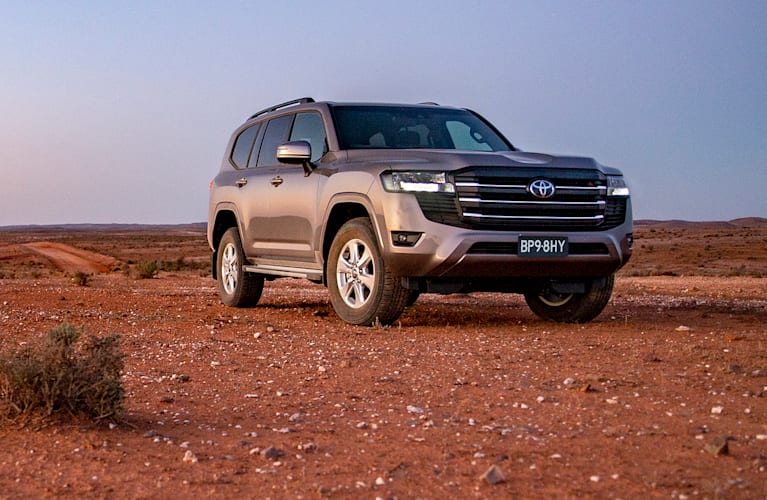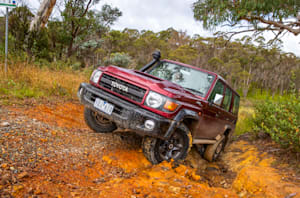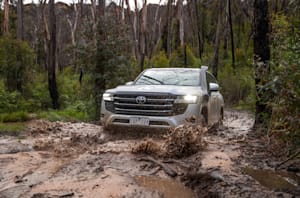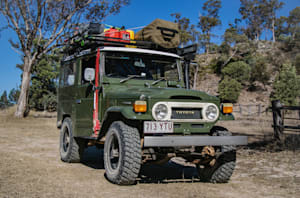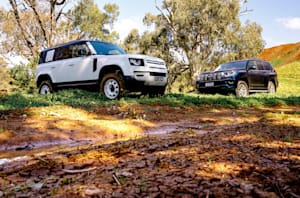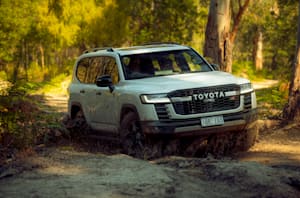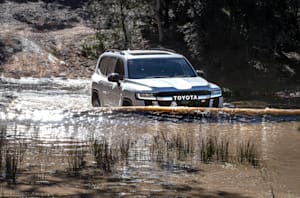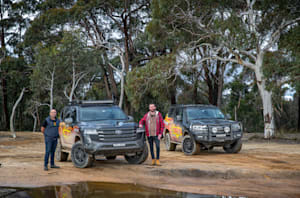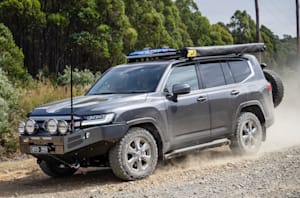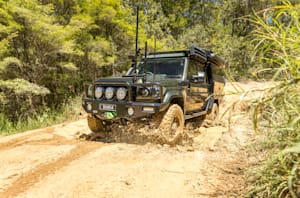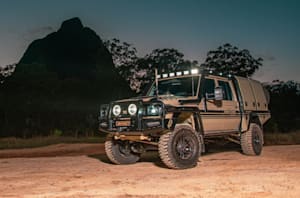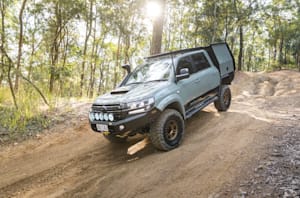The Toyota LandCruiser has become an Australian icon, ever since the 4WD was imported from Japan in the 1950s to be a workhorse on the Snowy Hydro Scheme.
The Toyota LandCruiser 300 Series replaced the long-serving 200 Series in 2021, with Toyota Australia dropping the 4.5-litre V8 engine from the spec sheet and offering a 3.3-litre V6 turbo-diesel as the only choice of engine.
Claimed by Toyota to be a ‘V8 beater’, the V6 generates 227kW and 700Nm and is mated to a 10-speed automatic transmission and full-time 4WD system. No manuals are available in the 300 Series shed.
The six models in the LC300 Series line-up are the GX, GXL, VX, Sahara, GR Sport and Sahara ZX, with all models coming with 110 litres of fuel and a 3500kg towing capacity.
The GX, GR Sport and Sahara ZX contain five seats, while the GXL, VX and Sahara all have a third row and seven seats in total.
With front and rear locking differentials as standard, and the inclusion of the latest-generation Toyota Kinetic Dynamic Suspension System, the GR Sport is the most off-road focused of the bunch.
Latest Review
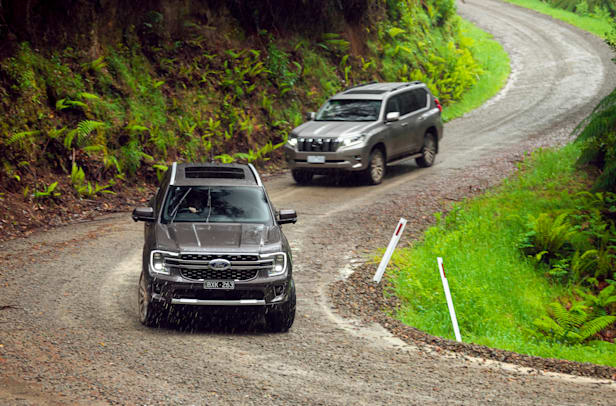
2023 Ford Everest Platinum versus 2022 Toyota Prado Kakadu
Is the new Everest the vehicle that can genuinely challenge the dominance of the Prado? We line them up in top specification to find out
Ford's 2022 Everest 4x4 wagon is all new and could be the vehicle to finally challenge the decades-old dominance of the Toyota Prado on the mid-size 4x4 wagon segment.
The aging Prado has really had this segment to itself for so long, while even the second-best selling vehicle in the segment, Isuzu’s MU-X, hasn’t come close to matching the Prado in sales numbers.
Other vehicles in the class such as the previous generation Everest, the Mitsubishi Pajero Sport, the SsangYong Rexton, Haval H9 and even Toyota’s Fortuner haven’t had a look in for many years. Ford Australia is hoping to break that hoodoo.
November 14, 2022: Next-gen Prado imagined
With new reports surfacing that the next Toyota Prado will get hybrid powertrains, we've commissioned a pair of artist renderings that might offer a look at the new model's styling. Get all the details, including everything about the hybrid powertrains, at the links below.
Story continues
The 2022 Ford Everest has the potential to turn the segment on its head.
With a bigger, bolder appearance, new levels of features and safety equipment, the choice of V6 or 4-cylinder diesel engines and new models in the line-up, could this be the 4x4 wagon to take it to the Prado’s popularity?
Toyota was only able to offer us its top-of-the-range Prado Kakadu for the review, so we selected the Everest Platinum to test against it here. Price for price, we would have preferred a $76,348 Prado VX.
Pricing
The 2022 Ford Everest Platinum starts at $76,880 plus on-road costs and is only offered with the 3.0-litre V6 diesel engine. The 2022 Toyota Prado Kakadu starts at $86,998 plus on-road costs and comes with the only engine offered across the Prado range, the 2.8-litre 4-cylinder diesel engine.
It’s also worth noting that prices of Ford Everest will go up when the 2023 production starts in February. For the Platinum model, this will mean a $649 increase to $77,530, while the steel underbody protection and a black-painted roof will be standard equipment.
Ford Everest Platinum
Arriving to the market just months after the 2022 Ranger ute with which it shares its T6.3 chassis architecture, the Everest wagon takes the model to a whole new level of refinement, equipment and drivability. The Everest is offered in entry-level Ambiente models followed by the Trend, Sport and Platinum as we are testing here.
The Ambiente, Trend and Sport models can be bought as 4x2 vehicles, while all are offered as 4x4. The Ambient and Trend models come with the 4-cylinder bi-turbo diesel engine only, while the Sport is offered with a choice of 4-cylinder and V6, and the Platinum only comes with the V6 diesel engine.
Powertrain and performance
The Everest Platinum only comes with the V6 diesel engine which only recently debuted in the latest Ford Ranger. Producing 184kW of power and 600Nm of torque, the V6 diesel which is related to the engine that was used in the Ford Territory SUV, places the Everest as a unique vehicle in its class.
The V6 engine delivers seamless torque throughout its rev range and while not earth-shattering in its performance, its smooth, quiet power delivery contributes significantly to the Everest’s high levels of cabin quietness and refinement.
The engine is aided in this regard by the 10-speed automatic transmission which has been redeveloped since its introduction in the previous model where it was behind the 4-cylinder engine. It’s now smoother and more precise in its shifting and faultless in its performance.
One small gripe we have with the 10-speed is its manual shifting application which is done using thumb buttons on the right-side of the transmission gear selector. These buttons are small and not as tactile or usable as a fore-and-aft movement of the shifter itself or even paddle-type levers behind the steering wheel.
Four-wheel drive Everests feature a new transfer case that offers 2WD, 4x4 auto, 4x4 locked high range and 4x4 locked low range settings. The previous generation of Everest had an on-demand 4x4 system that didn’t give the driver the option of 2WD.
Actuation of the transfer case is easy via buttons within a dial on the console. Turning the external ring of the dial selects the multi terrain modes for normal, towing, Eco, Slippery, Mud/Ruts and Sand driving. There’s also a locking rear differential that integrates with the electronic traction control on the front axle.
All these modes and features can also be selected via the off-road display in the huge centre dash screen after pressing the off-road button on the console.
On-road ride and handling
Like the Ranger ute, the Everest wagon uses a separate ladder chassis to which the body is mounted. Between the chassis and those big alloy wheels is an independent front suspension featuring double wishbones and coil springs, while at the back is a live axle suspended on coils and a multi-link set-up utilising a Watts-link for lateral location of the axle.
It’s a suspension design that has served the Everest well over the previous generation of the model and is made better thanks to a wider wheel track and longer wheelbase for improved stability, handling and ride control.
The suspension features no fancy electronics or air adjustment and nor does it need it. It soaks up bumps and potholes very well, cushioning the occupants against everything our poor roads can serve up.
Speaking of big alloy wheels; the Platinum rides on massive 21-inch wheels wearing 275/45 aspect tyres. Even with these large diameter wheels and low-profile tyres, the dynamics, ride and comfort of the Platinum are exceptional. There is a no-cost option for more sensible 18-inch alloy wheels and all-terrain tyres plus metal instead of plastic underbody protection for anyone planning to take their Platinum off road. These tyres should make the ride comfort even better.
The Ford‘s suspension is firmer and more composed than the more compliant and plush set-up in the Prado Kakadu. It delivers a more sporting ride that will better reward enthusiastic drivers.
Off-road
The previously mentioned dual-range 4WD transfer case, rear differential lock, electronic traction control and multi drive settings all combine to make the Everest pretty handy off road.
The wider wheel track of these so-called Next-Gen Fords not only makes them more stable at speed but also gives a bit more suspension travel at the tyre to keep them on the ground for best traction.
It’s still not great wheel travel and the Everest picks up wheels easily but the well-calibrated ETC does an excellent job of keeping the car moving. The low-profile 21-inch tyres don’t help either but again, the optional 18s and all-terrain tyres would be a better choice.
Towing
The Everest has a 3500kg maximum towing weight, which is the class standard and better than many others in the class. The Prado, for example, is only rated to tow 3000kg.
Everest also includes the groundbreaking trailer technology that debuted on the new Ranger including the Sync 4 set-up, integration and towing checklist, and an integrated factory electric brake controller if you tick the optional towing package.
There’s also a Tow/Haul mode in the drive settings that best calibrate the vehicle for pulling weight. The Gross Combined Mass (GCM) is rated at 6250kg.
Interior
As the top model in the Everest range, its 7-seat interior comes loaded with features and safety.
Safety-wise, there is AEB, side airbags that extend through to the third-row occupants, a centre airbag between the driver and front seat passenger, lane-keeping assist that has road side detection so that it doesn’t rely on the white lines, tyre pressure monitoring system, blind-spot indicators, reversing emergency brake, trailer-sway control, 360° camera, and radar cruise control.
The blind-spot indicators work with the Sync 4 trailer set-up to take in to account the length of your trailer and adjust the range it works over – clever tech!
Comfort-wise, there are heated and cooled leather seats with powered 10-way adjustment up front, heated and sliding second row, and split folding third row. The centre of the dash features a 12-inch screen that includes all your A/V controls, HVAC and Ford Sync 4 functions, while ahead of the driver is a 12.4-inch configurable digital dash that allows you to set up your gauges and info to how you like to use it.
Wireless Apple CarPlay and Android Auto are also standard as is a wireless phone-charging pad in the console. We did find that the wireless charging made the phone quite hot and preferred to use a cable plugged in to the USB port.
The Platinum also gets a panoramic glass sunroof and a kick-arse Bang & Olufsen 10-speaker sound system among its standard features.
There’s plenty of room for front-seat passengers, while room is adequate for two adults or three kids in the second row. The third-row seat is surprisingly accessible for an adult, but a tight squeeze once you’re in there. They fold flat into the floor when not in use to give a large, long cargo space with a 12V power outlet back there.
The steering column is manually adjustable for both reach and height, and there’s an automatic parking system that reverse parks the car hands-free.
A more useful feature are the Matrix LED headlights that automatically dim and vary the LEDs used when they detect oncoming traffic.
Practicalities
If you’re buying the Platinum to use as a 4WD, then the 21-inch wheels are not very practical so best to tick the option for the 18-inch wheels if getting them dirty is your plan. You’ll find a much wider range of all-terrain tyres to suit the 18s than you will for the 21s, and will be much more secure on rough roads.
Other than that, the Everest presents as a very practical wagon for family adventures. It’s spacious, has class-leading levels of technology, safety and ability, and it ticks all the boxes in terms of features.
You can really see that Ford looked hard at how Australians use their vehicles and what they want in them, and designed a vehicle around those parameters.
Being closely related to the Ranger ute, there is an abundance of accessories available to allow the owner to build the Everest to suit his or her needs. These come from both Ford and the aftermarket, and also include Ford’s partnership with ARB to offer ARB accessories that are covered by the factory Ford warranty, provided they were ordered at the time of vehicle purchase.
Something else to consider if you are kitting your Everest up for adventures, the standard roof rating is 100kg (4x4 models) which is about standard for this type of vehicle, but if your Everest has the panoramic moonroof or 21-inch wheels (which that Platinum has as standard) that capacity drops to 80kg (4x4).
That’s worth thinking about before you buy, particularly when you look at the weight of some of the rooftop tents on the market that could put you over capacity before you get anywhere.
Toyota Prado Kakadu
The Prado might be one of the oldest vehicles still being sold new, but spend some time behind its wheel and you soon know why it is the perennial favourite among Australians who like to get out and explore this great land. It’s a vehicle that is aging very well in our harsh conditions.
The current 150 Series Prado was released at the end of 2009, but it was essentially a reskin of the 120 Series which debuted way back in 2002. So, it’s really a 20 year-old platform, but in that time there has been the reskin, spec changes, new engines introduced, new variants, the introduction and discontinuation of the 3-door Prado, the loss of the V6 petrol engine and manual gearboxes, and plenty of rolling changes.
Australia now has a four-model Prado range starting with the GX and followed by the GXL, VX and top-of the-range Kakadu which we have on this drive.
Powertrain and performance
All current model Prados in Australia are powered exclusively by the latest version of Toyota’s 2.8-litre diesel 4-cylinder engine backed by a 6-speed automatic transmission and full-time, dual-range 4WD system.
In its latest tune which was updated in 2019, it produces 150kW of power and 500nm of torque. Along with the increases in output, the updates included a new turbocharger and fuel injection system plus revised balance shafts resulting a more refined delivery of power. The engine is still not 6-cylinder smooth, but it is an upgrade that was well needed.
Driving in the Prado Kakadu, you are well-insulated from any driveline noise, and the power and torque are well-matched to the vehicle. The engine is flexible in its wide torque range, but does get noisy when you put you foot down for overtaking or steep climbs.
The 6-speed transmission does a good job in day-to-day driving and the ratios are well-matched, but it’s not as smooth as the 10-speed in the Ford. While I appreciate a smart transmission with grade logic that shifts back when you might want some engine braking, the Prado’s Aisin ’box can be a bit aggressive in this regard, making it annoying in the suburbs when is shifts back and revs high going down hills.
Like the Prado as a whole, its drivetrain shows its age but, like so many older things, there’s nothing really wrong with the way it gets the job done.
On-road ride and handling
Like the Everest, the Prado is a traditional 4x4 vehicle in that it uses a body-on-frame architecture with a live axle at the back and independent suspension up front. But that’s really where the similarities end, as the Toyota is tuned for rougher roads and a more comfortable ride by using a softer, more compliant suspension calibration.
The Prado soaks up bumps and potholes better than the Ford wagon, but it wallows and pitches through corners and under brakes. While neither of these wagons are sports cars, the Prado is less so and less rewarding to drive dynamically.
On the other side of the coin, the Toyota delivers a more comfortable ride over rougher roads. The more compliant suspension soaks up bumps and ruts to protect the occupants from the harshness of the road.
The Kakadu is the only model in the Prado range to replace its rear coil springs with adjustable airbags to give a bit of height adjustment for off-road use. We find these to be detrimental to the ride quality from the rear end which doesn’t deal as well with sharp bumps that it does in other Prados on coils. This alone would steer me toward the VX grade that is still well specified but keeps its coil springs.
Off-road
The Prado’s softer suspension calibration makes it well-suited to off-road use, where its long-travel rear suspension works really well thanks to the clever KDSS, allowing the electronic traction control to do its job easier.
The 4WD system in full-time, but you can lock the centre diff in high and low range and there’s a locking rear differential as well.
Off-road electronics also include a multi-terrain mode selector and Toyota’s amazing Crawl Control system that edges the car forward though the toughest conditions with no throttle inputs from the driver. It’s essentially a low-speed, off-road cruise-control system with five speed settings, that will get you unstuck when traction is limited.
The Prado’s taller and more upright cabin, when compared to the Everest, is also a benefit off road as the big glasshouse gives plenty of vision for the driver. The Kakadu’s 360° camera helps as well in tight places.
Towing
Ford is the only manufacturer we’ve seen to really think about towing with the systems that it has implemented in the latest Everest and Ranger models.
There’s no such tech in the Prado or any LandCruiser, but the Prado does have a 3000kg weight capacity and built-in electronic trailer-sway control as part of its electronic stability control system.
The Kakadu’s GCM is 5990kg so its trumped by the Platinum even though the Ford is a heavier vehicle.
Interior
The Prado’s more upright and taller cabin space makes it feel more like a 4WD than the Everest does, but in this Kakadu trim it doesn’t miss out on any of the comforts and features you expect in a top-of-the-range model.
The front seats are power adjustable and heated and cooled, all seven seats are leather trimmed, there’s a refrigerated cool box in the centre console, a premium 14-speaker JBL sound system, glass moonroof, 3-zone climate control, a Blu-ray player with a pair of screens for back-seat passengers, and a leather and woodgrain steering wheel. The outboard seats in the second row are also heated.
The Kakadu’s steering column is power adjustable for both height and reach.
Some things like that woodgrain steering wheel and the silver backing on the switchgear look a bit old school but they are functional and easy to use. Similarly, the 9-inch screen for the A/V and sat-nav looks small when compared to that in the Ford but it contains all you need even if you do need to plug your phone cable in to access Apple CarPlay and Android Auto.
I prefer the simple analogue gauge cluster of the Toyota over the complicated configurable one in the Ford. It’s easier to read at-a-glance and still tells me everything I could want to see while driving. There’s a 4-inch information display between the main gauges that scrolls through the info menus.
The Prado’s safety kit includes Lane Departure Alert with steering assist, Pre-Collision Safety system with pedestrian and daytime cyclist detection, Automatic High Beam, Active Cruise Control and Road Sign Assist, rear cross-traffic alert, blind-spot monitors, rear parking sensors, stability and traction control. Again showing its age, the Prado misses out on some of the latest safety tech such as lane keeping assistance, lane cantering and AEB.
The third-row seats are again tricky to access and best left to the kids, while second-row passengers enjoy plenty of head and leg room but the narrower cabin makes shoulder room tight for three across.
The third-row seats fold flat into the floor, but at a taller height than those in the 5-seat, lower grade Prados so they sacrifice a bit of luggage space. The cargo space is taller and longer than that in the Everest but narrower.
Practicalities
You don’t maintain your position as the market leader in adventure-ready, family 4x4 vehicles for decades without knowing how to make them practical. While many will criticise the Prado for lacking in style and excitement, it makes up for it in practicality.
With a platform that is near-on two decades old, the Prado is well-proven and has had its bugs ironed out. There’s also more accessories available for it than you could ever need, so there’s plenty of kit out there to make it yours.
The Prado comes standard with the spare wheel mounted on the rear door and this allows an extra fuel tank underneath giving the vehicle 150 litres capacity, more than any other standard 4x4 on the market. Our test car was fitted with the optional ‘flat tailgate’ which makes the door easier to open but puts the spare tyre back under the car where that extra fuel tank should be, so it’s restricted to 87 litres of diesel on board.
Speaking of tyres, the Kakadu rides on 19-inch alloys from the dealer but the brakes are the same size across the Prado range so there’s no reason you couldn’t fit more practical and durable 17-inch wheels and tyres to it. We recall that when Toyota upped the Prado’s wheels to 19s that the 265/55 aspect tyre was an odd size and there were not many all-terrain alternatives to it without stepping up a size, spurring anger from some buyers.
The Kakadu has a 3000kg towing capacity and 640kg payload so all those luxury features like powered leather seats, console fridge, moonroof and so on really eat into the 2990kg GVM meaning the Platinum Ford trumps the Toyota on weight capacities.
VERDICT
Let's get one thing straight here – these are both excellent 4WD wagons. Perfect for family use, excellent for adventuring and great baselines to build exceptional touring wagons from.
Which of the two is better is really up to you and what you want of them.
The Ford Everest offers the latest technologies including infotainment and safety plus the refinement and performance of the V6 engine and 10-speed transmission. It has a more passenger-car feel to it than the Prado’s traditional 4x4 wagon delivers, and the way it sits on the road, handles and drive are also closer to a passenger car than a high-riding 4x4.
Plus, at this end of their respective model ranges, the Platinum is some $10K lower priced than the Kakadu – for now.
The Toyota Prado is the market leader for good reason. It feels more like a 4x4wagon; it’s tall and upright offering great visibility all around it. It’s 4-cylinder engine rattles more like a traditional 4x4 vehicle’s engine would too, however, we think that Toyota has gone a long way to suppress its sound in the Kakadu; it’s certainly quieter in this application that in the Hilux SR-5 we tested not too long ago.
"If I were buying a wagon to kit up for a lap of the map, it would be the Prado"
For mine, if I was looking for a modern family 4x4 for mostly town-use with the occasional trip away to the bush, it would be the Everest. Its levels of performance and refinement can’t be matched by the Prado and it would be an easier car to live with day to day, particularly for someone who is not accustomed to a large wagon. With a few well-chosen modifications, the Everest would also make an incredible outback tourer, in any of the 4WD models.
But if I were buying a wagon to kit up for a lap of the map it would be the Prado, but not in Kakadu spec because of the rear suspension. The Prado feels more like a 4x4 should and it’s a well-proven platform to build on, one that’s been tried and tested by tens-of-thousands of adventurers before you.
The gruffness of the engine isn’t so noticeable when you’re ponding along unsealed roads and the ability to carry 150 litres of fuel without fitting an aftermarket tank is a huge bonus.
Scoring
Specifications
News
-
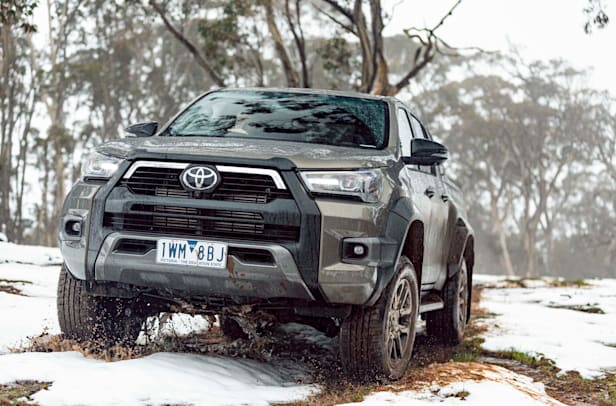 News
NewsVFACTS November 2022: HiLux back on top as SUVs outsell LCVs
Sales climb again in November with most brands experiencing growth, and SUVs proving particularly popular
-
 News
News2023 Toyota LandCruiser 70 Series receives price rise, AEB and GVM upgrade
The updated LandCruiser 70 Series workhorse has arrived with a $1600 price rise – but order books remain closed
-
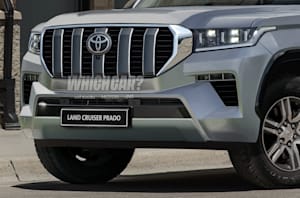 News
NewsNew Toyota Prado due mid-2023 with hybrid powertrains, new looks
Japanese reports suggest an updated LandCruiser Prado is coming mid next year packing hybrid power
-
 News
NewsToyota sued in class action over alleged diesel emissions defeat devices
Madden Lawyers launched the class action against the auto giant
-

Toyota LandCruiser 70 Series sales paused for at least six more months
-
VFACTS September 2022: Supply boost gives car brands bumper month – with Tesla Model Y nabbing a top 10 spot
-
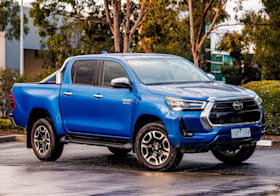
VFACTS August 2022: Brighter skies emerge for new car sales
-
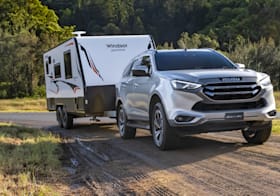
Towing: How much can my large SUV tow?
